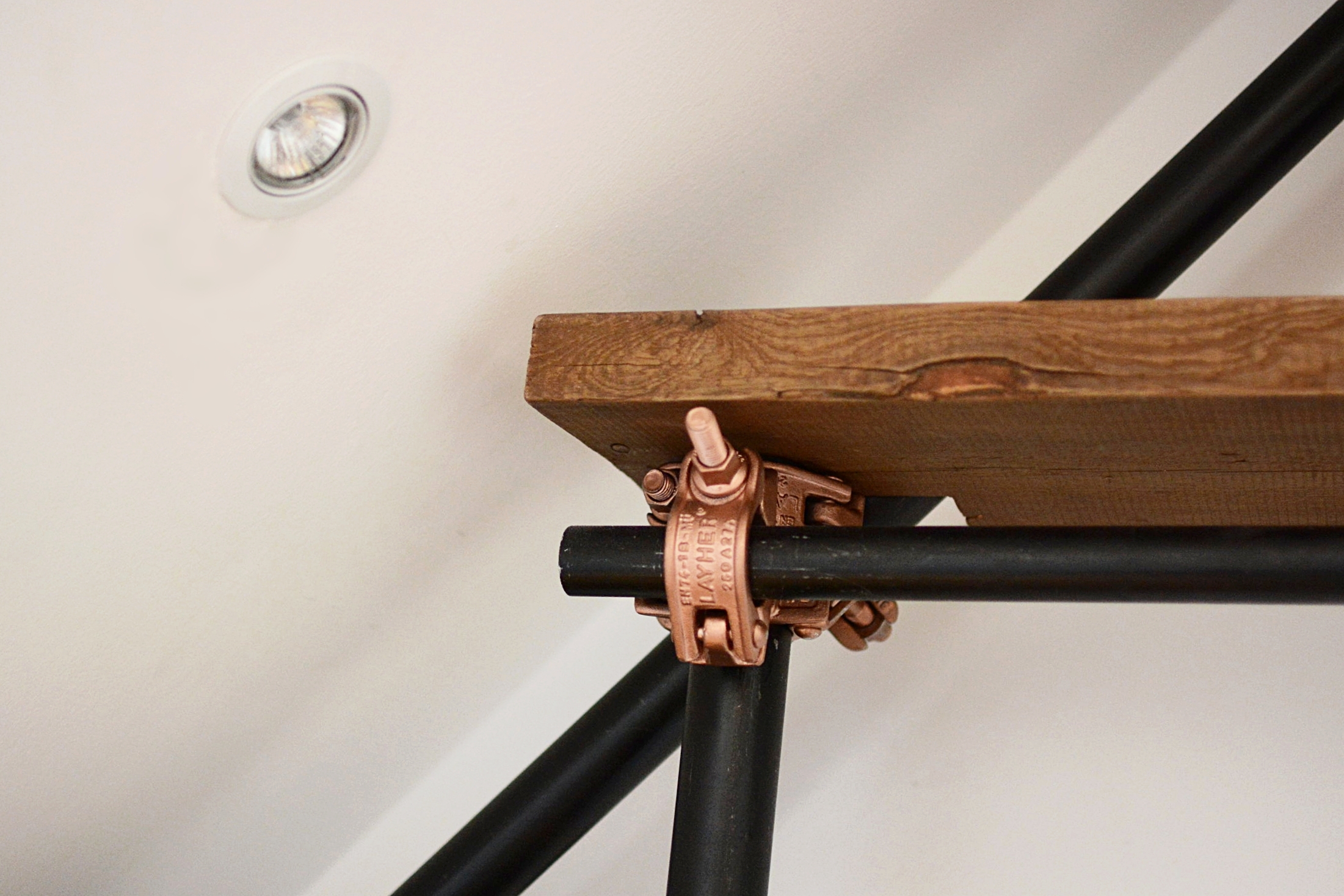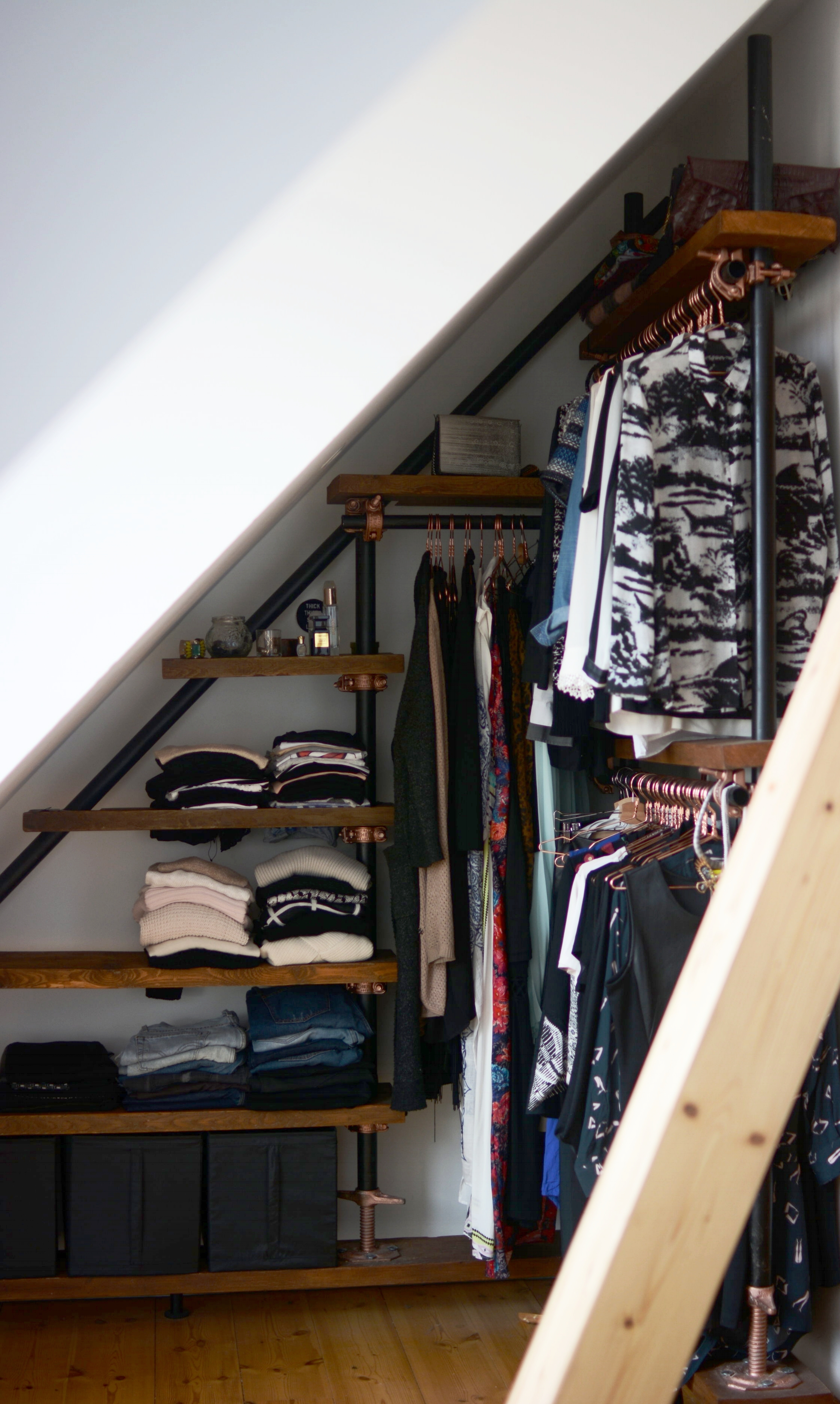CUSTOM RECLAIMED PIPE & BOARD WARDROBE
In the summer of 2015, I moved into a new rooftop loft here in Berlin (The Sky Loft (or Dachwohnung), now available as an AirBnB, if you're interested). Like many Berlin flats, it was a solid space but a bit of a fixer-upper (for one with modern tastes). Thus, I built a copper shower curtain arrangement for the tub, installed new lighting, planted vines and other vegetation and went out and bought some furnishings. As a slothy celebration, I rigged a Mexican hammock (given to me by a generous friend) to the chimneys flanking our rooftop. Finally, as I like to build stuff AND enjoy industrial style, I also reconnected with my love for reclaimed materials and began scavenging again.
'Reclaimed,' 'found,' 'repurposed,' 'recycled,' 'salvaged' or just plain 'stolen,' some of my favourite furnishings have been made with shit I've either found or lifted from various places. Most of the time it's derelict stuff left on the side of the road, randomly found in a basement or pulled out of a rubbish heap while making my way home, materials or pieces overlooked by someone who either didn't need them or simply didn't share my inclinations. (Yes, I am conscious and respectful of the morality behind all of this, and no, I do not outright steal from people).
My workbench tabletop is made out of a long paint-spattered board found on Raumerstraße one Sunday afternoon. My simple coffeetable is made of old planks of construction wood I found piled in a park. I engineered a monster easel out of scrap wood and leftover parts. Some of my favourite pieces of art are large, colourful metal panels, once belonging to a mighty engine or turbine and since worn and rusted into strange, nearly forgotten remnants of industry. I have an innate fondness for natural materials in geometric and bizarre shapes, like cubes of cobblestone, cylinders of concrete, sharp chunks of Hawaiian moonrock and of course, bones.
It was this scavenger craftsman impulse that lead me to imagine and eventually construct a customized open closet for our bedroom. Having lived in Berlin for almost three years, when we first arrived I noted the simple, commonly used European scaffold systems, and always wanted to build something using a similar functionality. As part of a former attic, The Sky Loft has high ceilings, broad exposed structural beams and 45-degree angles on some of the north-facing walls. As such, the latter has made some of the rooms a bit awkward to arrange (I still sometimes bump my head in the bathroom). In the bedroom, there's really only one area across from the bed to house a wardrobe, and yet any rectangular closet makes the triangular space look... kinda odd.
I'm not sure whose idea it was to optimize this space with a custom design, but it quickly became a tangible blueprint. After measuring and considering the space itself, I refined my initial doodle with mathematical particulars, fittings and material specs. I would revise it a few more times before deciding on a final design, but not much changed from inception to construction: it was to be a basic scaffold structure, designed to hang as many dresses and clothes as possible on three racks of varying lengths, as well as provide a comfy home for shelves of folded items, racks of heels and pieces of jewelry. Now all I needed to do was find the materials.
This proved to be both surprisingly easy and extremely difficult, resulting in an elongated construction process dependent on some specific items. In contrast to North American cities, most residential construction sites in Germany are left open after hours, leaving raw building materials piled on a street or loosely fenced. I won't get into the opposing cultural nuances of this here, but some discarded and/or used materials proved to be extremely easy to procure, and others took some very dedicated scouring. Once found, All of it had to be carried five flights up, by hand, one or a few pieces at a time. All in all, it took about six months to complete.
The boards are four centimetre-thick German pine, stained to match the existing colour of our baseboards, doors and trimming. I sanded them all by hand, measured and cut them each with a handsaw. The pipes are 50mm and 30mm aluminum pipes, cut with a hacksaw (I couldn't find a pipecutter large enough to accommodate that diameter!) and coated with the same matte black all-weather metal spraypaint as Schiffer.
The fittings are heavy double-sided cast metal screw clasps, cleaned and spraypainted copper. The mounts are adjustable scaffold bases, also spraypainted copper. The feet are simple four-inch black table legs, and the bolts are 6cm dipped aluminum. The superfancy adhesive LED strip underlighting is operated by a small foot switch near the base, Last but not least, the copper clothes hangers themselves are from Primark.
I'm both satisfied and a little sad it's finished, as it was a fun, big project that required a lot of effort and engineering to pull off. Of course, it will probably never leave this apartment, so I think I'll have no problem seeing it every day.



























